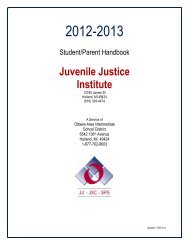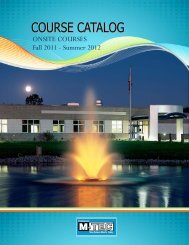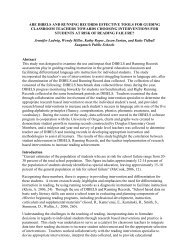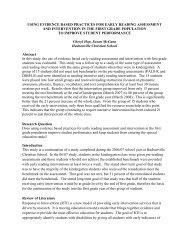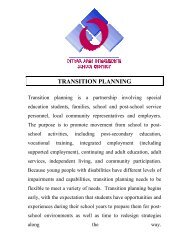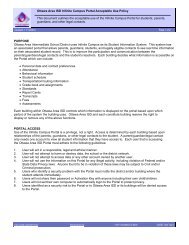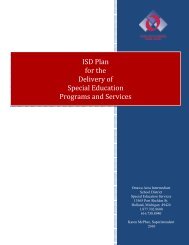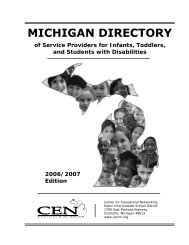Ottawa Area Intermediate School District Technology Planning ...
Ottawa Area Intermediate School District Technology Planning ...
Ottawa Area Intermediate School District Technology Planning ...
You also want an ePaper? Increase the reach of your titles
YUMPU automatically turns print PDFs into web optimized ePapers that Google loves.
OAISD <strong>Technology</strong> <strong>Planning</strong> – General Overview<br />
Within the <strong>Ottawa</strong> <strong>Area</strong> <strong>Intermediate</strong> <strong>School</strong> <strong>District</strong>, technology<br />
planning is a natural extension of the many planning activities that<br />
already exist within the organization including strategic planning, school<br />
improvement, annual budgeting cycles, and a myriad of other building<br />
and department level strategic and tactical planning activities.<br />
<strong>Technology</strong> planning is a dynamic process which seeks to continually<br />
enhance the capacity of the OAISD to achieve its mission, i.e., the vision<br />
for technology is that it be aligned with the broader educational and<br />
operational goals for the organization. This particular document serves as an overview of the technology<br />
planning and alignment that is continually in motion rather than being the result of distinct activity<br />
performed by a special committee. Indeed, to offer anything other than an illustrative overview would<br />
betray the paradigm of technology alignment in which we operate.<br />
The <strong>Ottawa</strong> <strong>Area</strong> <strong>Intermediate</strong> <strong>School</strong> <strong>District</strong> currently has three ‘over-arching” goals that guide its<br />
planning and operations:<br />
• Increased Student Achievement,<br />
• Improve OAISD and LEA Financial and Infrastructure Stability, and<br />
• Influence Political Decisions that Impact <strong>School</strong>s.<br />
These goals are the heart of the ISD’s educational mission to serve our community, our customers and our<br />
children and educators. These goals are encompassing in their breadth and depth and are the foundation<br />
for curriculum programming and technology support. The <strong>Ottawa</strong> <strong>Area</strong> <strong>Intermediate</strong> <strong>School</strong> <strong>District</strong> also<br />
exists within an operational environment that is constantly changing, e.g., OAISD provides services to<br />
approximately 40 autonomous LEAs in addition to continually adapting to changes in state and national<br />
requirements.<br />
<strong>Ottawa</strong> <strong>Area</strong> ISD is a dynamic organization – ever striving to meet the changing demands of its students,<br />
the LEAs, and state and federal requirements. As such, its planning processes reflect the need for<br />
flexibility and continuous improvement. An important step is the continual solicitation of input from the<br />
wide array of its constituents through many different systems. Examples of this include:<br />
• Affiliate Groups, for example<br />
o <strong>Ottawa</strong> <strong>Area</strong> Superintendents Association<br />
o <strong>Ottawa</strong> <strong>Area</strong> <strong>Technology</strong> Directors<br />
o <strong>Ottawa</strong> <strong>Area</strong> Curriculum Directors<br />
o Principals and Counselors<br />
o Business Directors<br />
o Transportation Directors<br />
o REMC7 Advisory Group<br />
• Parents and community participation, for example<br />
o<br />
o<br />
o<br />
<strong>Technology</strong> is both a tool<br />
and catalyst for change.<br />
Careerline Tech Center’s Business Advisory Committees (these committees meet<br />
regularly to assess program curriculum and recommend changes in teaching<br />
methodology, resources, technology and curricula to assure relevance with workplace<br />
skills and expectations)<br />
<strong>School</strong>s operated and managed by the Special Education Department are highly<br />
specialized and involve a great deal of parent interaction ranging from involvement in<br />
committees to IEPT meetings.<br />
Ad hoc – for example the recent Career Tech Education Vision process that solicited<br />
input from a broad cross-section of the community.<br />
6



